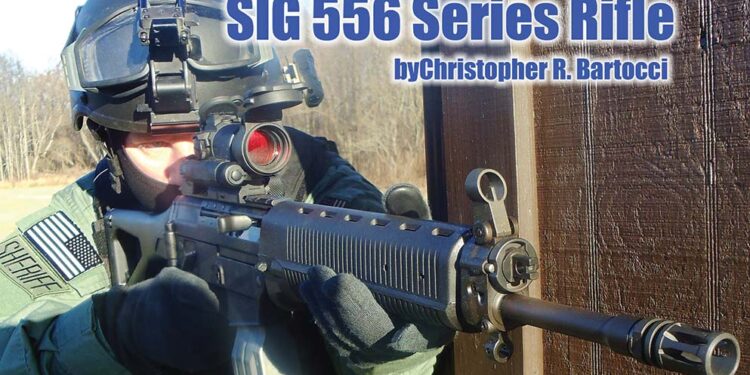By Christopher R. Bartocci
During the assault weapons ban, these so-called weapons were also banned from importation into the U.S. Although the Federal assault weapon ban sunset, the Federal import ban did not. Thus, the American market could not get new semiautomatic rifles made in Germany, Italy, Belgium, Austria and Switzerland.
In 2006, SIG USA became SIG Sauer and began production of their newest rifle, a variant of their SG550/551 called the SIG 556. This is manufactured in both law enforcement selective fire versions as well as commercially legal semiautomatic only rifles. The lineage of this family of rifles can be traced back to the early 1970s with the development of the SG540. Earlier prototypes go back even farther such as the SG530 series.

These families of weapon are all 5.56mm caliber and gas operated via long stroke piston with an AK-style rotating bolt. Most models had a gas valve that was adjustable for normal and harsh conditions by the shooter. Right up through the SG530, the rifles used polymer magazines that attached to the rifle in the same manner as that of the AK-series rifles. A lever in front of the trigger guard was pushed in and the magazine rocked out. Most of the magazines were manufactured of a translucent polymer enabling the shooter to view how much ammunition remained available for his weapon. The magazines also had an interlocking system that enabled magazines to be stacked side by side making for quick magazine changes (and a heavy weapon). Stocks were offered in both fixed as well as side folding manufactured of both metal and polymer. The rear sights are diopter sights such as that of the H&K series of rifles and submachine guns. The barrels ranged from 11.8 to 25.55 inches with 1/12, 1/10 and 1/7 inch rifling twist depending upon date of manufacture. One of the more significant changes came in the SG541 series with the recoil spring being moved to the operating rod rather than behind the bolt carrier.
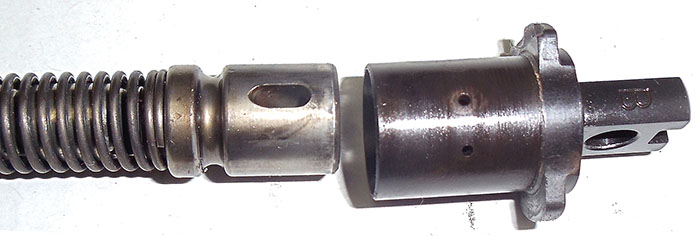
The SIG 556 series is based on this technology but updated in several ways. First the bolt carrier group and piston system are interchangeable with the SG 550/552 series but the receiver is not. This rifle, unlike many companies who are trying to make a direct gas rifle into a piston, was designed as a piston gun. The bolt carrier rides on two rails keeping it in line (no carrier tilt). This is the first of the breed to have a Mil-Std 1913 rail on top of the receiver to allow mounting of optics. This also allowed for a detachable rear sight. The track on the upper receiver, which the charging handle rides, has two pieces of hard rubber that seal it to keep dirt out of the receiver yet allows the bolt to cycle freely. The handguards come in some different variations. The 8.2 pound rifle provided for this article was the Classic model that had a two piece polymer handguard. Detachable rail panels can be placed in the front area of the sides and the bottom. Also, complete quad Mil-Std 1913 aluminum rail. The handguards come off when the rifle is disassembled. The rifle came with a polymer folding stock. With the stock extended it is 35.87 inches and with the stock folded a shorter 27.1 inches long.
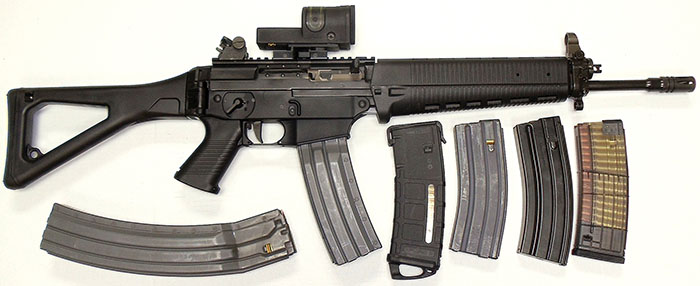
The 16 inch barrel is button rifled with a 5.56mm military chamber and chrome plated. It can be had with a standard M16A2-style compensator or without a muzzle device. The barrel is a lightweight profile. The gas block is pinned on with a roll pin. There are three holes drilled into the front sight base. The center hole is the gas port which goes into the barrel. Flanked on both sides are gas vent holes that lead out the left and right sides of the front base to release unneeded gas. The gas tube is entered into the front of the front sight base and locked in place by the stop pin.
The operating rod assembly is comprised of the operating rod and recoil spring. The recoil spring is captive. The piston itself is quite unique compared to most any out there. Traditional operating rods come to a flat or pyramid shape. The expansion chamber is made of the face of the piston with the rear of the gas block or gas valve. The gas is bled right into this chamber. The SIG 556 has a channel cut in the piston end that bleeds the gas through the inside of the piston and then to the end of the gas valve. The gas valve slides over the end of the operating rod. There are two port holes in the valve: one larger and one smaller. Under normal firing conditions the smaller diameter port is used, under extreme adverse conditions the larger gas port is used. The assembly is inserted into the front of the front sight base with the gas vale inserted and locked in place by the Stop pin. When clean, the valve position can be changed by hand easily; when dirty a cartridge or suitable tool needs to be used.
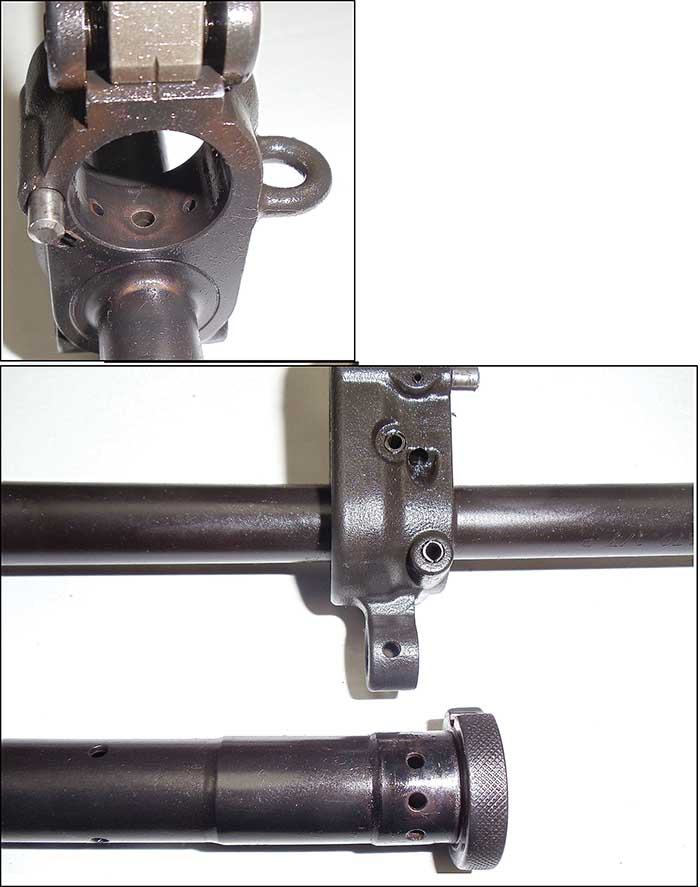
The bolt is very similar to that of an AK and sits in the carrier the same way. The bolt and carrier are slid into the rear of the receiver and a cut out in the carrier matches a notch on the operating rod. The charging handle latch in pressed and the charging handle is inserted completely assembling the unit. There are no parts behind the bolt thus increasing reliability. Having the recoil spring on the operating rod can be a double edged sword. One down side is that the heat from the barrel can cause the spring to weaken due to heat but the gas tube protects the spring from excessive heat. Overall the recoil system is well protected from the elements. The lower receiver is manufactured from 7075 T6 aluminum and accepts standard NATO STANAG (M16/M4) magazines. The rifle has an ambidextrous safety lever and the familiar M16/M4 style bolt catch. The pistol grip was my only point of criticism but that is only because I have Sasquatch size hands – it was rather small for me. There is both a front and rear takedown pin so the rifle opens up and comes apart like an M16/M4. The trigger had creep in it; this is a combat rifle not a precision sniper rifle, so it was acceptable for what it was. Due to the Classic model provided, it had a side folding polymer stock. When folded the rifle could be fired with no affect on reliability. It is only difficult to drop the magazine when the stock is closed. The rifle can be got in the SWAT variation with a telescopic stock (Quad Rail handguard), Designated Marksman Rifle with a Magpul PRS stock or Competition model with a fixed stock.
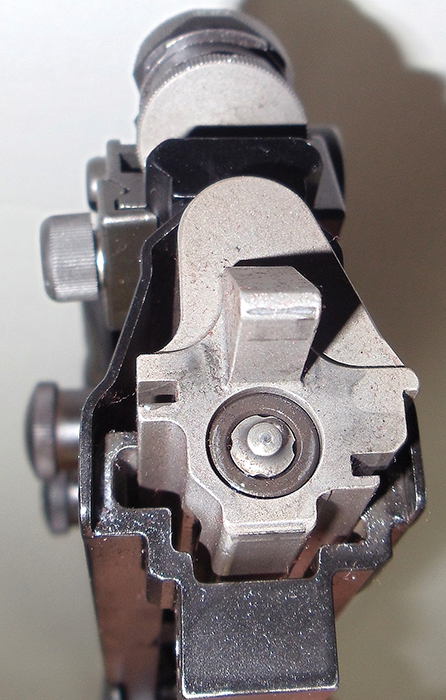
The rifle was equipped with an AimPoint Comp4S scope for close quarter shooting and a Trijicon ACOG (TA01NSN). The AimPoint Comp4S is the standard issue U.S. military sight differing from the standard Comp4 in that the battery compartment was moved from the top right side of the sight to the bottom of the right side of the sight by request of the Army. Undoubtedly one of the finest sights in its class, the dot intensity can be adjusted by a dial enabling it to be used in any lighting condition. The Trijicon ACOG is a 4x scope manufactured from a block of 7075T6 aluminum. The scope is powered by a tritium lamp as well as a fiber optic. This scope, in different variations, have been purchased in large numbers for use on the M16A4, M4 as well as the M240 and M249. It has a crystal clear optic and is ideal for a combat mid-range scope. Both attached to the Mil-Std 1913 rail on top of the rifle.
The rifle was tested with GI aluminum magazines, Magpul PMag, Lancer AWM, H&K and C-Product magazines. More than 600 rounds of Silver State Armory 5.56x45mm 55 grain FMJ (SSA10075-55FMJ) were fired with no malfunctions of any sort. For accuracy testing Silver State Armory 5.56x45mm 77grain open tip match (SSA10075-77OTM) ammunition was used. Shot groups averaged best at 3 inches at 100 yards.
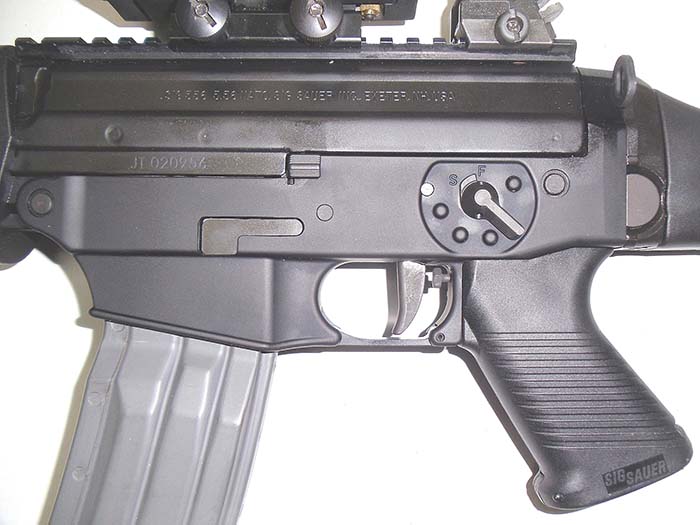
The Surefire 60 and 100 Round Magazine
Just at the time the SIG 556 rifle was received for testing, so was the long awaited Surefire 60 and 100 round magazines. In August of 2008, Surefire went to work to develop two reliable high capacity magazines. Traditionally, the largest capacity that was not a drum was 40 rounds. They were very long and often not reliable. To go over that would require a drum magazine that was heavier, bulkier and even more unreliable.
The concept is a magazine with four columns instead of two columns of cartridges. For example, a standard 30-round magazine has two columns each holding fifteen rounds. The Surefire magazine has four columns of fifteen rounds each giving sixty rounds. Although the magazine is wider, not much length is added and the full loaded magazine balances well in the center of the rifle making it an excellent primary magazine and it will fit in a double GI magazine pouch. If you do sixty rounds, why not one hundred rounds? They did that too with four columns of twenty five rounds each. The original concept was by L. James Sullivan who is also the designer of the 100-round Beta drum magazine. The actual patent is assigned to both L. James Sullivan and Robert (Bob) Waterfield.
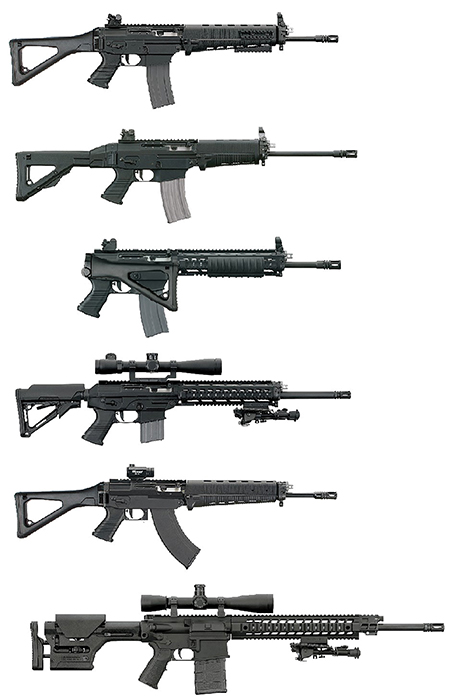
The first time this author saw a quad column magazine was nearly ten years ago in a photo of Val Shilin (Izhmash, Russia) firing an AN94 rifle (5.45x39mm) with a polymer quad column magazine. Where exactly the dates are between the developments of these two are left to be seen. The construction and quality of the magazines is very nice being very robust. Both a sixty and a hundred round magazine were provided to test and evaluate. The only way to easily load these magazines was with a MagLula loading tool or a StripLula depending on how the ammunition is packaged. Both magazines were loaded three times and fired in the SIG 556 rifle with no malfunctions. The magazine was also tested in a fully automatic LMT M4 Carbine with no malfunctions.
The evaluation was more of a tactical one since the reliability was shown with several reloads of both magazines. The sixty rounds are practical in every way and does not affect the shooter’s ability to go prone if need be. The shooter will be no more exposed that if he had a standard thirty-round magazine. The magazine is not too heavy either. Any soldier or SWAT officer would benefit from this magazine as it greatly increases the firepower on an individual level. The hundred round magazines although reliable are just too long. You cannot go prone with it and the rifle must be held off hand to use it. Even in a fighting position this magazine would be difficult to deploy. It is fun to shoot but little practical or tactical use.
The SIG 556 is sure to be very popular with American shooters. Those who want a proper built piston operated rifle will be right at home with this rifle. Commonality with the M16/M4 magazine is a great plus for the American shooter. SIG has also released their SIG 516, which is a piston operated version of the M4 and is competing for the individual carbine program that may determine the next U.S. service rifle. With the factory producing rifles in the U.S., the American consumer will have access to these high quality Swiss weapons.
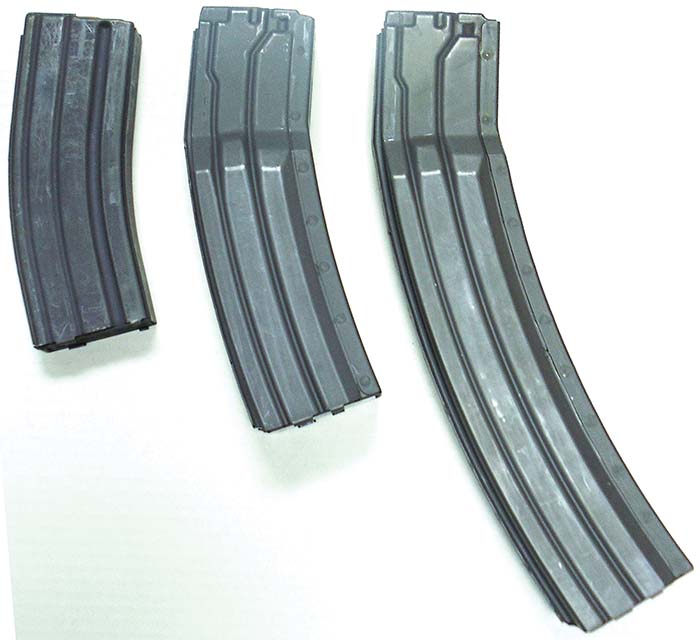
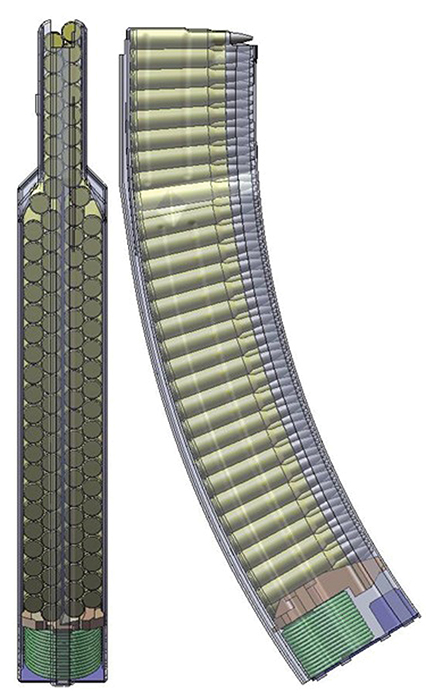
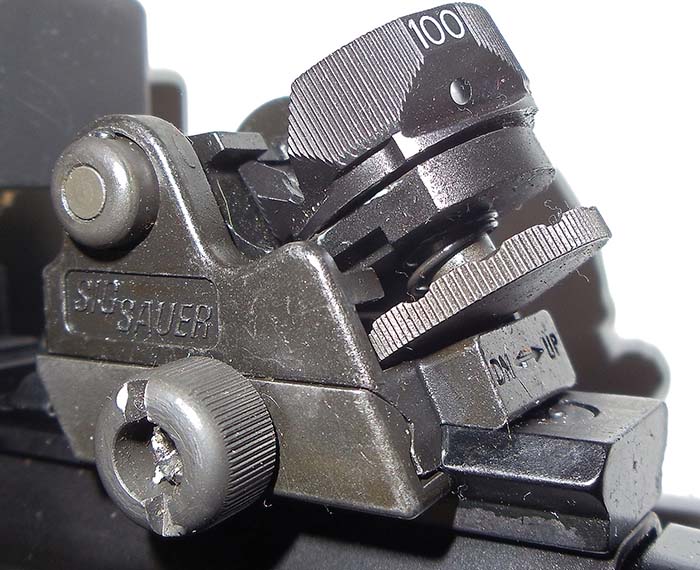
| This article first appeared in Small Arms Review V17N3 (September 2013) |



